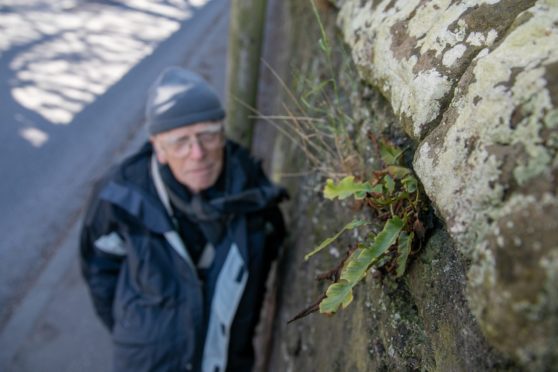It is the time of year when many of us decide to dust off our pruning gloves and spruce up our overgrown gardens.
But a north plant expert is calling on people not to aim for the perfect image of a neatly trimmed lawn this spring, saying that “untidy bits” are vital to help plant life survive.
Brian Ballinger is the Botanical Society of Britain and Ireland’s county recorder for Easter Ross, and is the owner of woodland in Tain, Caithness and Fife.
He has now made a plea to local authorities, railway operators and private gardeners to leave some of their green spaces looking a bit unkempt.
Mr Ballinger has recorded the plant life in railway stations on the Inverness to Wick and Inverness to Kyle of Lochash lines over the past two decades, and says he has noticed quite a decline in species between 2001 and 2020.
In 2001, his records show 186 species found in the 12 stations in Easter Ross, with each station hosting between 27 and 78 species.
But in 2020 the overall number had declined to 114, with station totals varying between six and 40.
Mr Ballinger, a retired psychiatrist based in Dundee, said: “Some parts of the stations that had been accessible in 2001 were no longer open to the public in 2020, having been fenced or re-developed.
“Network Rail has taken over station management from Railtrack and now there are usually daily visits by maintenance teams.”
He emphasised that he did not want to criticise Network Rail, but ask them to consider using less herbicides, and clear less ground of rotting vegetation.
“Sites have to be managed , but sensitively,” he said.
“At this time of year, you see lots of little flowers along the kerbs and roadsides, for example.
“They are very important for insects, and wild plants support wild life.”
A Network Rail spokesman insisted that any clearing of plant life was done after consulting with ecological experts.
He said: “Unmanaged vegetation can pose a serious risk to rail safety as trees can fall onto the line in bad weather or, when overgrown, branches and foliage can obscure signals from a driver’s view or damage overhead power cables in areas with electrified lines.
“We carefully manage the growth of vegetation within our railway to help control these and other potential safety risks.
“We also have a team of ecologists within our business to advise on the best way to reduce the impact of our works on wildlife and the environment.”
Last year, much of the Highland Council green estate was not managed due to the pandemic.
While some bemoaned the situation, Mr Ballinger said he observed a real comeback of some species as a result.
He said: “The meadow saxifrage, a declining species, appeared in graveyards all over Tain for example.
“I’m not suggesting the council doesn’t maintain its graveyards, but maybe leave a little untidy corner, and cut back on things like roadside mowing.
“Really I’m calling for councils to be a little less tidy where possible.”
A Highland Council spokesman said the local authority is working on such a policy.
He said: “Set aside areas are something the council’s amenities team is looking at. We are working on a policy on this with our environmental team, along with a weed control policy, eliminating the use of glyphosate weedkillers.
“We agree that a change in approach is hugely beneficial to our environment and are working towards this.”
Mr Ballinger is also monitoring the plants growing on urban and rural walls in Easter Ross and Dundee.
In Easter Ross, he found an average of 15 species growing town in walls, with 78 different species noted in 2020.
On rural walls, he noted 88 species growing in the 20 sections he monitored.
In Dundee, Mr Ballinger recorded sections of 50 urban walls and found 54 species.
These figures are largely unchanged in the past decade.
He said: “Look at your walls and enjoy the special plants growing on them things like ivy-leaf toad flax, a garden escapee, and small asplenium ferns.
“Only clean your walls if you have to.”
Mr Ballinger has recently been awarded the Royal Caledonian Horticultural Society’s Dr Patrick Neill Memorial Medal for his contribution to Scottish field botany, conservation and improvement of urban spaces.
He was Botanical Society of Scotland (BSS) president from 2017-19, and is also involved in a 10-year BSS project monitoring Scotland’s urban flora.
